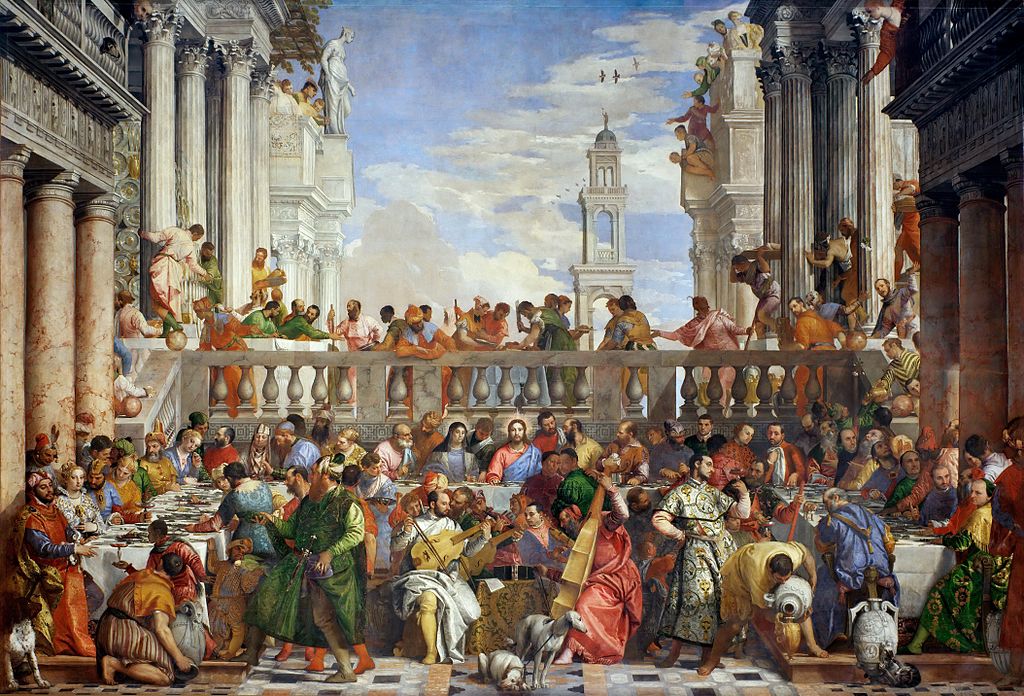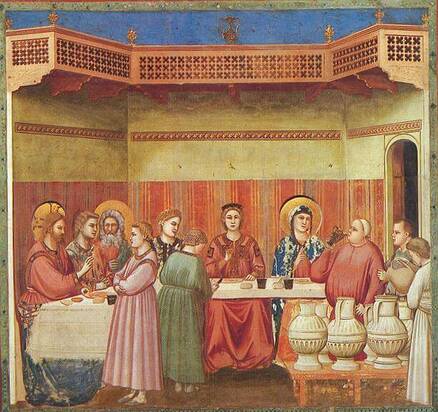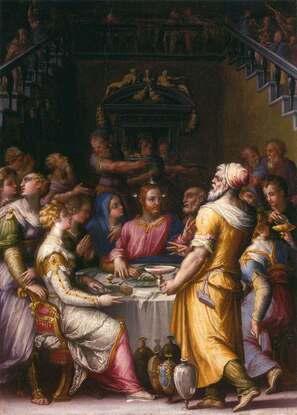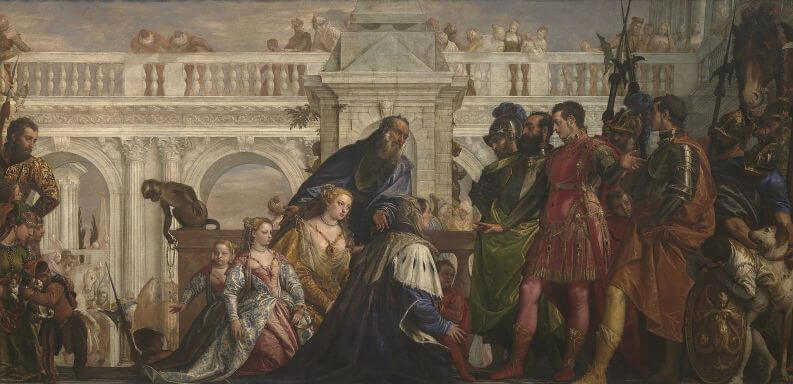|
Where? First floor, room 711 of the Denon wing in the Louvre
When? 1563 Commissioned by? The Benedictines of the monastery of San Giorgio Maggiore to decorate their refectory (silent dining-room). What do you see? This enormous painting of 7.40yd x 10.87yd (6.77m x 9.94m) shows the biblical story of the wedding at Cana in which Jesus converted water into wine. Jesus is sitting in the middle of the table, and Maria is sitting to the left of him (you can recognize them by their halos). They are surrounded by a mix of biblical figures and Venetian contemporaries of Paolo Veronese, including some of the other apostles, princes, Venetian noblemen, and servants. In total there are more than 130 people. The bride and groom are in the left bottom corner sitting at the table. A servant is offering a glass of wine to the groom to taste the new wine. The bearded ceremonial master, dressed in a green mantle, is standing behind the servant. On the right, you can see a man pouring the wine from one of the white stone water jars into a smaller jar. To the left of him is the head wine taster, who approves the wine. The wedding at Cana is illustrated as a lavish Venetian feast, evidenced by the abundance of 16th-century Venetian elements, such as the presence of Dorian (in the foreground) and Corinthian (in the background) columns, the clothing of many of the guests, the silver tableware, etc. Do you also see the dogs, birds, parrot, and a cat? Backstory: This painting is based on the story of the wedding at Cana in the Gospel of John 2:1-12. Mary, Jesus, and some of the apostles are invited to a wedding in Cana. During this multi-day wedding, they ran out of wine, and Jesus gave the servants the instruction to fill six stone water jars, each holding 20-30 gallons, with water. The water turned into wine and was better than the earlier wine that was served at the wedding. This was one of the first signs of the wonders that Jesus could do. It took Paolo Veronese 15 months to complete the painting (with some assistance of his brother). He created a very colorful painting, and some of these colors were very expensive and imported through the Silk Route from the Middle and the Far East. Symbolism: On top of Jesus, on the balustrade, meat is being cut. This is most likely the meat of a lamb and refers to Jesus as the Lamb of God (we can interpret the meat cutting as symbolism as the wedding guests are already eating their dessert, which means that the meat was already consumed earlier). The dog that is chewing a bone at the bottom of the painting refers to the sacrifice of Jesus at the end of his life. There are also several references to the wedding. The guests are getting quinces (a pear-like fruit) for dessert, which serves a reminder that bitterness and sweetness are mixed in a marriage. On the table in between the musicians stands an hourglass, which represents vanity. The dogs on the foreground of the painting are a symbol of loyalty. Why the wedding at Cana? On the one hand, the wedding at Cana is a great subject to express the opulence and beauty of the Venetian life. On the other hand, it still presents a biblical story, which can remind the viewers of the importance of Jesus. In this painting, Jesus is not interacting with the other guests like you would expect based on the biblical story, but he looks straight at the viewer. Jesus is sitting in the middle of the table instead of the bride and groom, who you would expect there. This shows that the religious motives (reminding viewers of the wonders that Jesus did) are more important than an accurate depiction of the biblical story. Other artists have also used the wedding at Cana as the theme of their paintings. Giotto created a fresco of the Marriage at Cana and Vasari created a painting of the Marriage at Cana.
Who is Veronese? Paolo Veronese (1528 – 1588) was born in Verona (which explains his surname). He is one of the three most important members of the 16th-century Venetian school of painters; the other members are Titian and Tintoretto. He is known for his large, dramatic, and very colorful paintings.
In his early years, Veronese used the Mannerist style, but later on, he returned, under the influence of Titian, to a more naturalistic style. Many of his magnificent works are nowadays on display in and around Venice. One painting that is outside Venice is The Family of Darius before Alexander, which is in the National Gallery in London.
Restoration: The painting has had a turbulent life.
Fun fact: This work is the biggest canvas painting in the Louvre and contains many funny details. Paolo Veronese included various contemporaries into the painting, not all of which we can identify nowadays. For example, the musician in white is a self-portrait of Paolo Veronese, and the musician in red is Titian. In addition, you can find various animals in the painting. On the top left, you can see a dog looking down at the feast. There are also two dogs at the bottom left, two dogs in the bottom middle, and a small dog walks on the table on the right. At the bottom right is a cat curled around the white water jar. On the bottom left, you can also see a midget holding a parrot. Interested in a copy for yourself? Poster or canvas
Written by Eelco Kappe
References:
1 Comment
figure 4
2/20/2018 02:24:33 pm
thank you for the help, it was very helpful
Reply
Leave a Reply. |
Categories
All
|
- Home
- Blog
-
Museums
- Alte Pinakothek
- Art Institute of Chicago
- Baltimore Museum of Art
- Barber Institute of Fine Arts
- Bargello
- Barnes Foundation
- British Museum
- Church of Sant’Anastasia
- Cleveland Museum of Art
- Courtauld Institute of Art
- Detroit Institute of Arts
- Frans Hals Museum
- Galleria Borghese
- Gallerie dell'Accademia
- Getty Museum
- Guggenheim
- Hermitage Museum
- Kunsthistorisches Museum
- Kunstmuseum Basel
- Legion of Honor Museum
- Louvre
- Mauritshuis
- Metropolitan Museum of Art
- Musee d’Orsay
- Museum of Fine Arts in Boston
- Museum of Modern Art
- National Gallery in London
- National Gallery of Art
- National Museum in Poznań
- Norton Simon Museum
- Ny Carlsberg Glyptotek
- Palace of Versailles
- Palazzo Pitti
- Palazzo Vecchio
- Petit Palais
- Philadelphia Museum of Art
- Prado
- Pushkin Museum
- Ravenna Art Museum
- Rijksmuseum
- San Diego Museum of Art
- Santa Maria delle Grazie
- St. Peter's Basilica
- Städel Museum
- Statens Museum for Kunst
- Tate Britain
- Tate Modern
- Timken Museum of Art
- Uffizi
- Vatican Museums
- Wallace Collection
-
Artists
- Altdorfer
- Anguissola
- Berlin Painter
- Bosch
- Botticelli
- Boucher
- Bronzino
- Bruegel the Elder
- Brunelleschi
- Cabanel
- Caillebotte
- Canova
- Caravaggio
- Carpeaux
- Cezanne
- Cimabue
- David
- Degas
- Delacroix
- De Maria
- Donatello
- El Greco
- Fontana
- Fra Angelico
- Fragonard
- Gauguin
- Gentileschi
- Gericault
- Gonzalez-Torres
- Goya
- Hals
- Hogarth
- Hokusai
- Ingres
- Leonardo da Vinci
- Lippi, Filippo
- Longhi, Barbara
- Lorrain
- Makovsky
- Manet
- Massys
- Matisse
- Merian
- Michelangelo
- Mochi
- Modigliani
- Monet
- Panini
- Parmigianino
- Perugino
- Picasso
- Pisanello
- Raphael
- Rembrandt
- Renoir
- Reynolds
- Rivera
- Rodin
- Rubens
- Scultori
- Seurat
- Steen
- Tintoretto
- Titian
- Toulouse-Lautrec
- Turner
- Uccello
- Van der Weyden
- Van Dyck
- Van Eyck
- Van Gogh
- Van Hemessen
- Vasari
- Velazquez
- Vermeer
- Veronese
- Vigée Le Brun
-
Locations
- Books
- About Us




